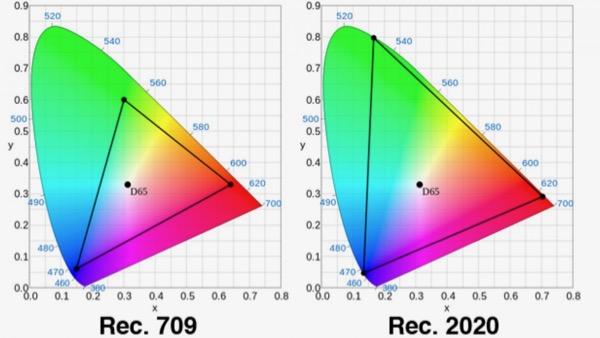Colors in Space

The charts show the colors visible to the human eye, with each point representing a specific wavelength of visible light. But no current display technology can cover all of these colors. The triangles shown indicate the smallest and largest of the three color gamuts mentioned above.
Rec.709, on the left, is the color gamut of the 1080p HDTV format that still dominates today’s program sources. As you can see, it covers barely a fraction of the visible wavelengths. But while we’ve lived happily with it for years, there’s far more to the Wonderful World of Color.
Rec.2020, on the right, is the standard for Ultra HD. It’s much bigger than Rec.709, but to my knowledge only Dolby Cinema-equipped theaters, with their laser projectors, can achieve full Rec.2020 today given equivalent source material. The current monitors used to master our program material fall well short of it, as do all consumer displays.
But when the Ultra HD format was created, sufficient space was included in its data storage and transmission capabilities to accommodate Rec.2020. You might have heard this data space referred to as the Rec.2020 container.
For today’s sources, however, this container is never more than partially filled. A third color gamut currently dominates UHD at the production end, called DCI-P3 (DCI for Digital Cinema Initiative). Its area falls between Rec.2020 and Rec.709, though slightly closer to the latter. It was developed for use in commercial movie theaters equipped with digital projectors (now widespread—almost universal so in the US) and designed to provide a match close enough to film to satisfy movie industry professionals.
Virtually all films are currently mastered for video on monitors having P3 color primaries. Those primaries are converted to Rec.2020 based coordinates, but the color values are identical, leaving the consumer with Rec.2020 color that only extends as far as the P3 color gamut within it.
The color you see on your well-calibrated UHD set today should therefore be the same as the colorist saw when he or she graded the film on a P3-capable monitor. But calling this color P3, at the consumer end, isn’t correct. What you’ll get is Rec.2020, but from a partially filled Rec.2020 container with the gamut coverage of P3.
There’s no “P3” specification for UHD color. When the UHD specifications were created by the Ultra HD Forum the only thing they say about the color gamut is that it must be wider than Rec.709 and also support (not necessarily reach) full Rec.2020.
Later a group of manufacturers, tech companies and Hollywood studios (not the same group that produced the format’s specs) got together as the Ultra HD Forum and produced a set of standards that set the requirements for a UHD set to carry a so-called “Ultra HD Premium” badge. One of these requirements was that it had to support at least 90% pf P3. This wasn’t exactly a cheat, but requiring a percentage of P3 (90%) looks much better on a spec sheet than an equivalent percentage (perhaps less than 70%) of Rec.2020. Even then such a number is relatively meaningless. It only says that on average the set must meet 90% of P3, not that each primary color point must equal 90% of P3.
Thus the legend of P3 for UHD was born. Just remember that there’s more to come from Rec.2020 Ultra HD color than the equivalent of P3but not yet.
Not to further complicate what is already a complicated issue (but I will), there’s even more to a set’s color than just what you see on a two-dimensional CIE chart. The important third dimension, luminance, forms the z-axis, turning the gamut into what is actually a color volume. But that’s a story for another time.





























































